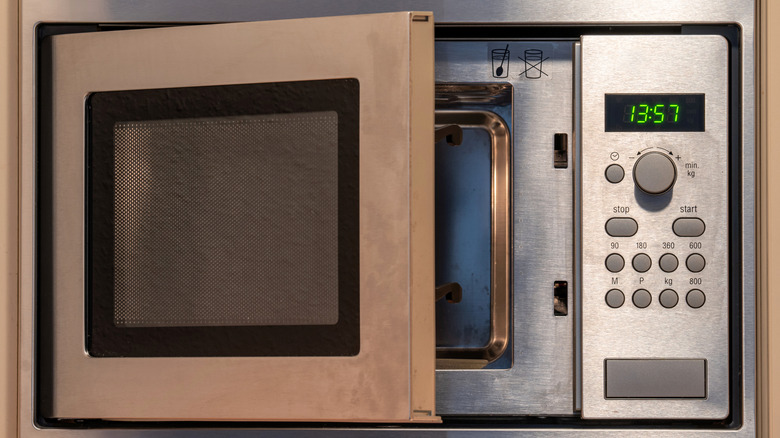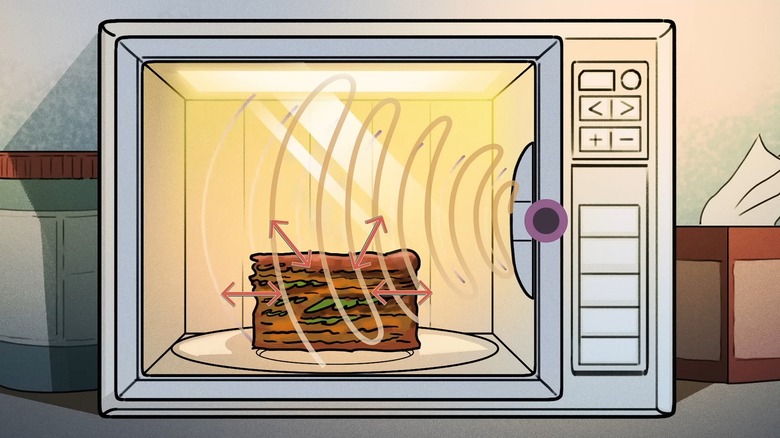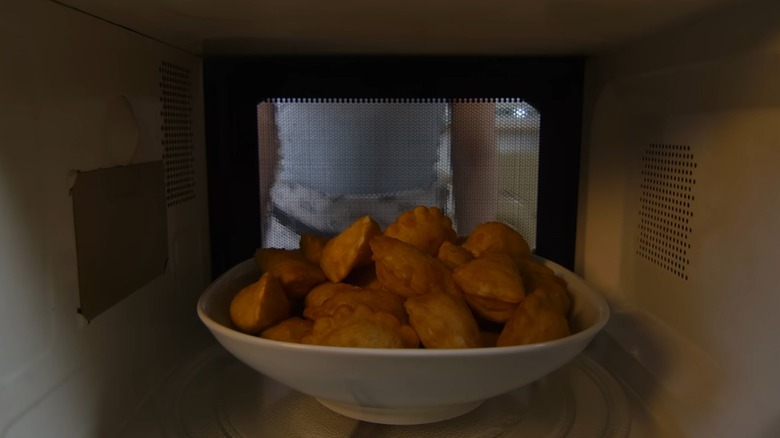Why Do Microwaves Have A Mesh Door?
Those short on patience or looking for a quick and easy meal have relied on a small cooking appliance in their homes that was originally invented in the '60s: the microwave. But while a microwave is seen as a common fixture in the majority of American kitchens today, its benign appearance hides some dangers that, without some protective measures, would be hazardous to humans. If you look closely at the door, you'll notice a mesh layer that features many tiny holes. Not only are these holes a very specific size, but they are strategically spaced to prevent the long electromagnetic wavelengths produced by the microwave from escaping into the kitchen.
While ultraconvenient, with the ability to heat food in minutes, where a traditional oven might take the better part of an hour, microwaves actually produce radiation. Fortunately, with measures like the mesh screen, not only are homes protected from radiation, but the small holes of the screen also provide a clear view inside the microwave, so you can see your food cooking.
Cooking food from the inside out
A traditional oven uses conduction to cook food, which uses elements to transfer heat from the outside in. While conduction is an effective way to bake or broil meals, it can take a while for the external heat to fully cook the inside of foods. A simple baked potato recipe, for example, can take over an hour.
However, a microwave can prepare food faster because it cooks from the inside out. The electromagnetic waves generated by a microwave flow through the items inside and bounce around the cavity as the appliance cooks. On a base level, these wavelengths cause water, fat, and sugar molecules in your food to vibrate, which generates heat.
While certainly quicker than an oven, this method does have a few drawbacks. You can't just pile a few scoops of leftovers on a plate directly in the center of a microwave, as you're likely to find the center cold. These electromagnetic waves work best when food is spread out in a uniform layer rather than mounded. Microwaves can also tend to dry out certain foods, making them less palatable. However, adding some moisture to the dish can help mitigate this issue. Of course, modern iterations of this appliance, such as multi-purpose microwaves, often feature several different methods for preparing food.
So, what if you somehow removed the mesh screen? Is this the only danger a microwave poses?
The majority of the human body is made up of water, with around 60 percent in grown males, per Thought Co. Considering that the microwave's wavelengths have a direct effect on certain molecules, the human body, if exposed, would heat up from the inside. Initially, you'd likely just feel a bit of warmth as the water inside the body began to increase in temperature. However, longer exposure could result in burns and a host of internal problems as your organs would eventually begin cooking from the inside.
This isn't the only hazard with regard to microwaves, as repairing one can be extremely dangerous without the proper knowledge and experience. However, this has nothing to do with radiation, but instead the risk of electrocution. Even after being unplugged from the wall outlet for a period of days, the capacitor within the microwave can still carry thousands of volts of electrical charge. Sadly, there have been documented deaths as a result of do-it-yourself microwave repairs, so seeking out a professional should always be the course of action. Although, considering, you can purchase new units for under $100, with several reliable home appliance brands available, repairing an old one might not be cost-effective.


